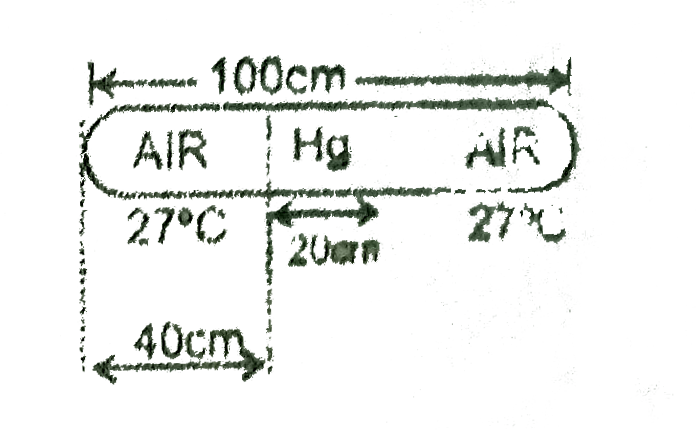A glass capiliary tube, sealed at both ends, is 100 cm long. It lies horizontal with the middle 10 cm containing mercury. The two ends of the tube ( which are equal in length) contain air at 27∘C, at a pressure of 76 cm of mercury. The tube is kept in a horizontal position such that the air column at one end is at 0∘C. The other end is maintained at 127∘C. Calculate the length of the air column which is at 0∘C, and also its pressure. Neglect the change in volume of mercury and glass.
Applying the gas equation to the left end,
76×45300=x×P273 and to the right 76×45300=P(90−x)400
Px273=P(90−x)400 (or) 400273x=90−x∴x=90×273673=36.51cm
∴90−x=90−36.51=53.49 ∴76×45300=36.61×P273
So, the pressure on the left end is equal to the pressure on the right end,
⇒76×45300×27336.51=P=85.24 cm of Hg
Topper's Solved these Questions
- EXPANSION OF GASESBook:AAKASH SERIESChapter:EXPANSION OF GASESExercise:TEST YOUR SELF
Explore 6 Videos
- EXPANSION OF GASESBook:AAKASH SERIESChapter:EXPANSION OF GASESExercise:VERY SHORT ANSWER TYPE QUESTIONS
Explore 18 Videos
- ELEMENTS OF VECTORS Book:AAKASH SERIESChapter:ELEMENTS OF VECTORS Exercise:QUESTIONS FOR DESCRIPTIVE ANSWER
Explore 10 Videos
- EXPANSION OF LIQUIDS Book:AAKASH SERIESChapter:EXPANSION OF LIQUIDS Exercise:QUESTIONS FOR DESCRIPTIVE ANSWERS
Explore 4 Videos
Similar Questions
A glass tube sealed at both ends is 100cm long, It lies horizontally with the middle 10cm containing mercury. The two ends of the tube contain air at 27∘Cand at a pressure 76cm of mercury. The air column on one side is maintained at 0∘Cand the other side is maintained at 127∘C. Calculate the length of the air column on the cooler side. neglect the changes in the volume of mercury and of the glass.
View SolutionA glass tube sealed at both ends is 100cm long, It lies horizontally with the middle 10cm containing mercury. The two ends of the tube contain air at 27∘Cand at a pressure 76cm of mercury. The air column on one side is maintained at 0∘Cand the other side is maintained at 127∘C. Calculate the length of the air column on the cooler side. neglect the changes in the volume of mercury and of the glass.
View Solution
Knowledge Check
Aglass tube scaled at both end is 1m long. It lies horizontally with middle 10cm containing Hg. The two ends of the tube, eqaul in length, contain air at 27∘C Neglect the chang in length of Hg column. Then the change in length on two sides is
A12.3 cmB10.311 cmC9.9cmD8.49cmA thin tube of uniform cross-section is sealed at both ends. It lies horizontally, the middle 5 cm containing mercury and the two equal end containing air at the same pressure P. When the tube is held at an angle of 60∘ with the vetical direction, the length of the air column above and below the mercury column are 46 cm and 44.5 cm respectively. Calculate the pressure P in centimeters of mercury. (The temperature of the system is kept at 30∘C).
A75.4B45.8C67.5D89.3
In the given figure a glass tube lies horizontally with the middle 20cm containing mercury. The two ends of the tube contains air at 27∘C and at a pressure 76cm of mercuy. Now the air column on one side in maintained at 0∘C and the other side is maintained at 127∘C. Find the new length of the air column on the cooler side. Neglect the changes in the volume of mercury and of the glass.

View SolutionIn the given figure a glass tube lies horizontally with the middle 20cm containing mercury. The two ends of the tube contains air at 27∘C and at a pressure 76cm of mercuy. Now the air column on one side in maintained at 0∘C and the other side is maintained at 127∘C. Find the new length of the air column on the cooler side. Neglect the changes in the volume of mercury and of the glass.

View SolutionA thin tube sealed at both ends is 90 cm long. It is kept horizontally, the middle 10cm containing mercury and the two equal ends containing air at standard atmospheric pressure. The tube is turned and kept in vertical position. By what amount will the mercury be displaced?
View SolutionA thin tube, sealed at both ends, is 100cm long. If lies horizontally, the middle 10cm containing mercury and the two equal containing air at stan-dard atmospheric pressure. If the tube is now turned to a verical position, by what amount will the mercury be displaced ?
View SolutionA thin tube of uniform cross section is sealed at both ends. It lies horizontally, the middle 5cm containing mercury and the parts on its two sides containing air at the same pressure p. When the tube is held at and angle of 60∘ with the vertical, the length of the air column above and below the mercury pellet are 46cm and 44.5cm respectively. Calculate the pressure in centimeters of mercury, The temperature of the system is kept at 30∘C.
View SolutionA thin tube of uniform cross-section is sealed at both ends. It lies horizontally, the middle 5 cm containing mercury and the two equal end containing air at the same pressure P. When the tube is held at an angle of 60∘ with the vetical direction, the length of the air column above and below the mercury column are 46 cm and 44.5 cm respectively. Calculate the pressure P in centimeters of mercury. (The temperature of the system is kept at 30∘C).
View Solution
